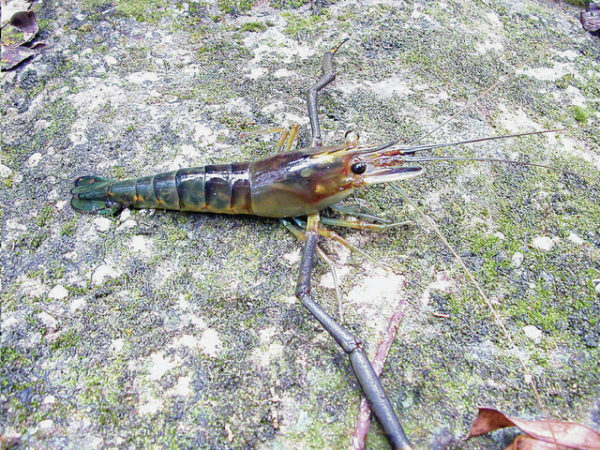Published in the Ocean Watch column, Honolulu Star-Advertiser © Susan Scott
December 10, 2016
I had the pleasure of spending the long Thanksgiving weekend on Molokai with friends. After exploring that island’s remarkable beaches, we signed up with a local family for a guided hike up Halawa Valley to its waterfalls. On the walk along the stream, I found, to my surprise, an outstanding marine animal: a Tahitian prawn.
The other common name for this prawn is giant freshwater shrimp, which begs two questions. Is the creature a shrimp or a prawn, and does it live in salt or fresh water?
Both and both.
 Tahitian prawns, also known as giant freshwater shrimp, can be found in streams
Tahitian prawns, also known as giant freshwater shrimp, can be found in streams
and waters off all Hawaiian Islands since their introduction to the state in 1956.
Public Domain photograph courtesy Wikimedia.
The words shrimp and prawn are not scientific names. They’re regional. People in the U.K. and other Commonwealth countries usually call the small edible species shrimp and the large ones prawns. In the U.S. most all are called shrimp, although large, freshwater ones might be called prawns.
The genus of the Tahitian prawn is Macrobrachium, meaning large arms. Males’ second pair of walking legs are long, thin and end in curved pincers. From head to tail the creature grows to 6 inches.
Despite the common name Tahitian, the species is native to East Africa, the Indian Ocean and throughout Indonesia to the Marquesas Islands. But it’s not native to Hawaii.
In 1956 state workers brought to Hawaii 340 of the prawns from Guam, releasing 94 in Pelekunu Stream, today a spectacular preserve on Molokai’s north shore. A year later state workers released 27 prawns in Oahu’s Nuuanu Stream.
For the next nine years, no one found a single prawn, causing people to believe the introduction a failure. Then in 1965 a fisher caught a large Tahitian prawn in a Big Island stream. By 1969 people had spotted the prawns in 42 streams on all islands.
The prawn had spread throughout the islands on its own. It could do that because the creature has a remarkable oceangoing phase in its life cycle.
After prawn eggs hatch, they wash to the sea. The tiny swimming larvae spend three to four weeks in the open ocean growing molt by molt. After 22 to 31 molts, the creature reaches the last molt before it becomes a proper prawn. But if it hasn’t found the fresh water it needs for its adult form to thrive, the baby is able to delay that last molt until it finds a stream.
The well-intentioned introduction of Tahitian prawns to Hawaii succeeded in establishing a new food source, but as usual, it came at a cost. The prawn eats anything it can find, including Hawaii’s native stream animals.
When during our Halawa hike I found a perfect large molt on a rock next to the stream, our guide said, “Tahitian prawn. We get them by the basketful. They taste great.”
That’s good, because Tahitian prawns are clearly here to stay.